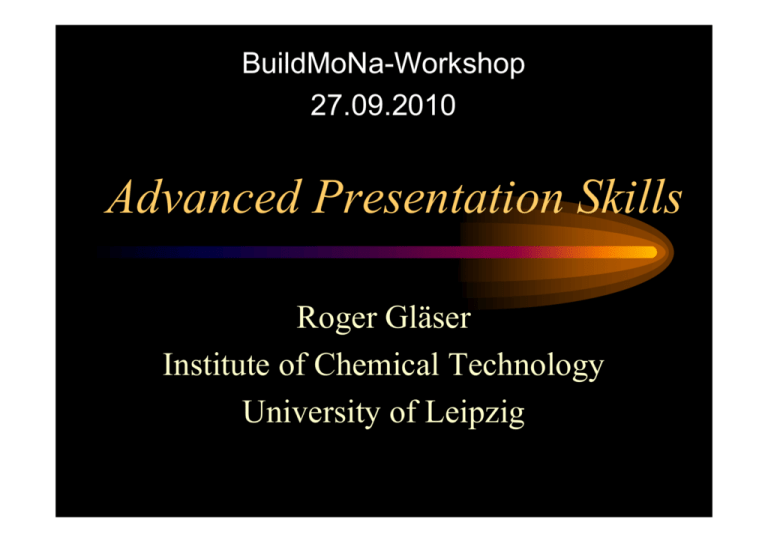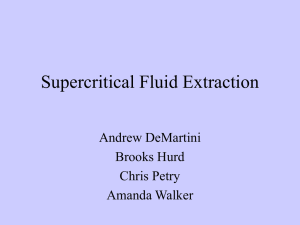Instructions for Workshop Advanced Presentation Skills on 27
advertisement

BuildMoNa-Workshop 27.09.2010 Advanced Presentation Skills Roger Gläser Institute of Chemical Technology University of Leipzig Bottom Line • More People Fear Speaking Than – Snakes – Sharks – Flying – Heights • You Can Enjoy Speaking • You Can Speak Successfully Outline • Preparation • Presentation • Physical Skills • Handling Questions • Summary Outline • Preparation • Presentation • Physical Skills • Handling Questions • Summary Preparation • Audience Analysis • Organization and Outline • Visual Aids • Practice Preparation: Audience Analysis • Purpose of Talk • Who Is Your Audience • Tell Them What to Do Audience Analysis 1 • Purpose of Talk –What is the Problem –What is your Goal –What Action Do You Seek –Omit all Details -- Focus Audience Analysis 2 • Who Is Your Audience –Background –Language –What Do THEY Want –Can They Do What You Want –What Is the Merit of Your Goal Audience Analysis 3 • Tell Them What to Do –Conclusion First -- Bottom Line –Options è Recommendation –Be Specific and Quantitative –Help them Sell Your Ideas –Timeframe for Action –Short and to the Point Audience Analysis: Example High Pressure To Aircraft Air Jet Fuel • Options – – – – Elevate, Gravity Drain High Speed Pumps Less Volatile Fuel Pressurize with N2 • Communicate With Airport Intermittent Fueling System Exceeds Ignition Limit – Airport Manager – Chief Engineer for City – Local Newspaper Preparation: Organization and Outlining • Purpose – Process is Easier – Presentation is More Effective • • • • Goal Setting Brainstorming Outline Result: Less Effort, Less Stress Organization and Outlining: Goal Setting • Define Your Goal • Do Audience Analysis • Focus on the Action You Seek • Keep it Short and Focused Organization and Outlining: Brainstorming • Write it All Down –Details –Vast Concepts • Ignore Ordering • Avoid Being Judgmental Organization and Outlining: Outline Development • Group Ideas • Do Conclusions First • Do Introduction Next • Do Main Body Last • Cut Everything You Don’t Need The Attention Curve 1 typically … The Attention Curve 2 Organization and Outlining: Outline Development 2 Organization and Outlining: Conference/Seminar • Minimum of Background • Avoid Semantics • What Have YOU Done? • What Difference Does It Make? • Where Does it Go from Here? Organization and Outlining: Progress Report • • • • Executive Summary, < 1 Page New Findings this Period Plans for Next Period Overall Goal -- What Do We Win if We Win? • Request for Input Preparation: Visual Aids 1 Types of Visual Aids • • • • • • • Overheads Slides Blackboard Flipchart Printed Handout Video Tape Demonstration Comparison Factors • • • • • • Ease of Preparation Cost Effectiveness Flexibility Reusability Size of Audience Preparation: Visual Aids 2 • Types of Slides – Word, Graph, Table, Drawing • Focus on Goals of Talk – Leave Out Excess Baggage • Use of Slides – One Idea per Slide – Creativity, Highlights Preparation: Visual Aids 3 • Less than eight informations per slide Preparation: Visual Aids 4 • Limited number of colors Preparation: Visual Aids 3 • Make it BIG, BIGGER Advantages of Supercritical Fluid CO2 for Phase Transfer Catalysis • More and more industrial processes are now taking advantage of the unique properties of supercritical fluids. • It is well known that CO2 is normally regarded as being environmentally benign. • Supercritical fluids have low viscosity and high diffusivity for enhanced mass-transfer. • It is extremely easy to separate the solvent from the reaction products. • This same technique could be applied advantageously to other reactions. SCF CO2 For PTC • Environmentally Benign • Enhanced Mass Transfer • Solvent Removal • Other Reactions Graph Example 16.00 14.00 12.00 T EM P E R A T UR E , C TIME, MINUTES 10.00 50.00 60.00 70.00 8.00 80.00 90.00 100.00 6.00 4.00 2.00 0.00 0.00 5.00 10.00 15.00 20.00 CONVERSION, % 25.00 30.00 35.00 40.00 Alternate Graph Example Conversion, % 15 Temperature 10 100 C 70 C 5 50 C 0 0 5 10 Time,min 15 20 Local Composition Enhancement Mole Fraction of Acetone Near a Phenol Blue Molecule, SCF CO2, 100 bars, 35°C Bulk Spectroscopic Eq. of State 0.0111 0.0513 0.0443 0.0306 0.0975 0.0895 0.0512 0.1316 0.1098 0.0734 0.1698 0.1533 Data of Kim and Johnston, 1987 Local Composition at a Phenol Blue Acetone in SCF CO2 at 35°C, 100 Bars 15 10 % Acetone 5 0 BULK SPEC. EOS (Kim and Johnston, 1987) Process Alternatives Liquid Solvent SCF Solvent Nearcritical Fluid Major Capital Equipment, K$/yr. Ancilliary Equipment Control Systems Foundations, Piping, etc. Total Equipment Cost Working Capital Total Capital Cost, K$/yr. 9800 1960 1372 2254 15386 200 15586 7100 1420 994 1633 11147 201 11348 5800 1160 812 1334 9106 202 9308 Chemicals, K$/yr. Labor Maintenance Supervision and Overhead Insurance and Taxes Depreciation and Interest Total Operating Costs, K$/yr. 19800 200 1078 150 300 3117 24645 18300 200 781 150 250 2270 21951 17400 200 638 150 250 1862 20500 Product Price, $/kilo Annual Product Production, Mkilo Total Income, K$/yr. Net Profit 1.58 20 31600 6955 1.58 20 31600 9649 1.58 20 31600 11100 Return on Investment, %/yr. Payout Time, Months 45 27 85 14 119 10 A Graph is Always Better: Process Alternatives 120 ROI, %/yr. 80 Payout Time, Months 40 0 Liquid Solvent SCF Solvent Nearcritical Fluid Return on Investment, %/yr. A Simpler Graph is Better Yet: Process Alternatives 120 80 40 0 Liquid SCF NCF CO2 Absorption in PMMA by IR Absorbance 1.5 C 1.0 O 0.5 O C O 0.0 700 680 660 Wavenumber (cm 640 -1 ) Supercritical and Nearcritical Fluids For Extraction and Reactions Transport Ability Gases Supercritical Fluids Liquids Solvent Power Typical SCF Extraction Process Solid Feed is Batch; Fluid Cycle is Continuous Feed Pressure Reduction Extractor Separator Extract Removal Repressurization CO2 Enhanced Aqueous Extraction Vapor Vapor GXL Organic Aqueous Aqueous CO2 • Much CO2 Dissolved in Organic Phase • Little CO2 Dissolved in Aqueous Phase • CO2 is a Poor Solvent for Hydrophilic Species • Recycling of Hydrophilic Catalysts Pharmaceuticals -- Merck • Natural Products • Safe, Clean Solvent – Carbon Dioxide • • • • Extraction Purification Patents Filed Albany Plant CO2+Methanol+FC-75 20 °C, 49 bar OVERALL PURITY SCF CO2 Purification of Biomedical Polymer 100.0 99.5 99.0 98.5 Feed Product Single Stage, 40°C, 100 bars Summary • Multidisciplinary Collaboration – Engineers Synthesize Catalysts – Chemists Do Process Design • Sustainable Technology – More Benign Processes – Improved Products, Economics • Novel Solvent Systems – Supercritical Fluids – Nearcritical Fluids – Gas-Expanded Liquids Outline • Preparation • Presentation • Physical Skills • Handling Questions • Summary Preparation: Practice • Practice • Practice • Practice • Practice The Presentation • Getting Ready – Be Prepare – Arrive Early – Check Room, Projector, etc. • Getting Started • Giving the Presentation • Ending the Presentation Getting Started • • • • • • Relax, Be Enthusiastic Get in Touch The First Minute Never Apologize Give your Bottom Line Outline the Talk Giving the Presentation • No Text, No Notes • Prepare for Each Visual • Preview Each Visual – Tell Them What They are Seeing – Give Enough Time to Digest Ending the Presentation • Summarize – Action Item – Timeframe • Never Run Over • Tell Them You’re Through Physical Skills • Eye Power • Voice Power • Body Power Physical Skills: Eye Power • Problem – Scanning • Negative Effects – Causes Nervousness – No Individual Recipients – Accelerated Pace • Solution – Lock Eyes – Hold for Entire Thought – Move Around Room – Avoid Looking at Projector, Screen Physical Skills: Voice Power • Problems – Too Low – Monotone – Too Fast • Negative Effects – Difficult to Hear – What is Important? – Frustrating to Follow • Solutions – Speak Loudly – Speak Clearly – Use Inflection – Pause Frequently Physical Skills: Body Power • Problems – Shifting – Moving Without Purpose – Locking Hands – Holding Objects • Negative Effects – Lower Confidence – Distraction • Solutions – No Notes – No Pointer – Balanced Stance – Hands to Sides – Gestures when Appropriate Handling Questions • Problem – Lacks Structure • Negative Effects – Less Control – Increased Pressure – Group Discussion • Solution – Build Structure – Procedure Handling Questions: Preparation • Know Your Weak Spots • Figure Out Most Likely Questions • Prepare Answers – May Use Extra Visuals • Plant Key Questions Handling Questions: Procedure • • • • • • You Choose the Questioner Listen to the Whole Question Turn Away from Questioner Restate Question As You Wish Make Answer Brief and Focused Do Not Become Emotional Handling Questions: Attitude • Avoid Feeling Defensive • Adapt Answer to Purpose of Question – Seeks Clarification – Raises an Objection – Shares Information • General Guidelines – Stay Positive -- Be the “Good Guy” – “I Don’t Know” Summary • Steps to Follow – Preparation – Presentation – Physical Skills – Handling Questions • Communications – More Enjoyable – More Effective BuildMoNa-Workshop 27.09.2010 Advanced Presentation Skills Roger Gläser Institute of Chemical Technology University of Leipzig







